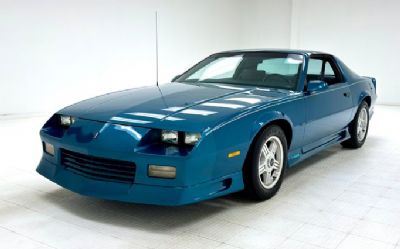Welcome to the ultimate source for Classic & Muscle Car Research.
 The third-generation Chevrolet Camaro, produced from 1982 to 1992, is a distinctive chapter in the Camaro's history that reflects the influence of evolving automotive trends, advancements in technology, and shifts in design philosophy. This era saw the Camaro adapt to changing market demands and regulations while continuing to capture the essence of American muscle cars.
The third-generation Chevrolet Camaro, produced from 1982 to 1992, is a distinctive chapter in the Camaro's history that reflects the influence of evolving automotive trends, advancements in technology, and shifts in design philosophy. This era saw the Camaro adapt to changing market demands and regulations while continuing to capture the essence of American muscle cars.
The design of the third-generation Camaro showcased a sleeker and more aerodynamic profile compared to its predecessors. A front-wheel-drive chassis was considered but ultimately abandoned in favor of a rear-wheel-drive setup. The Camaro featured a lower roofline, wraparound glass, and a more refined appearance, aligned with the design language of the 1980s. Pop-up headlights and a rear spoiler were among the defining styling elements.
The third-generation Camaro initially faced challenges due to tightening emissions standards and fuel economy concerns. Engine options included four-cylinder and V6 engines, but the true muscle car spirit was kept alive with V8 engines, albeit with reduced power outputs. The introduction of fuel injection technology enhanced efficiency and performance. While the 1980s marked a decline in raw power due to emission regulations, the Camaro continued to be available in high-performance variants, including the Z/28 and the IROC-Z.
The third-generation Camaro embraced advancements in technology and safety features. Fuel injection improved fuel efficiency and engine response. An electronically controlled transmission became available, enhancing driving dynamics. Interior amenities were upgraded, offering improved comfort, convenience, and infotainment options.
The Z/28 model, known for its track-oriented performance, continued to be a highlight of the third-generation lineup. The Z/28 was equipped with handling enhancements, performance suspension components, and powerful V8 engines, capturing the spirit of the original muscle car era while adapting to contemporary standards.
The IROC-Z (International Race of Champions) package, introduced in 1985, further emphasized performance. It featured a tuned suspension, distinctive graphics, and a reputation for offering impressive handling and driving dynamics. The IROC-Z symbolized the era's penchant for performance-oriented aesthetics.
The third-generation Camaro navigated through a period marked by changing consumer tastes and a focus on efficiency. As automotive technology evolved, the Camaro incorporated electronic advancements that shaped the driving experience and paved the way for future innovations.
Despite facing challenges posed by regulations and market shifts, the third-generation Camaro's legacy is a testament to its ability to adapt and endure. Its sleek design, technological advancements, and emphasis on performance variants demonstrate the Camaro's commitment to capturing the essence of the times while staying true to its heritage.
In summary, the third-generation Chevrolet Camaro represents an era of transformation for the iconic muscle car. With its sleek design, technological advancements, and performance-focused variants, it encapsulates the automotive trends and challenges of the 1980s while maintaining the Camaro's status as a symbol of American performance and style.
'92 Camaro RS
'92 Camaro RS
'88 Camaro IROC
'86 Camaro Convertible
'86 Camaro Z/28 IROC-Z
'82 Camaro Z28 Coupe
'84 Camaro Coupe
'84 Camaro Z/28
Advertise Now!






